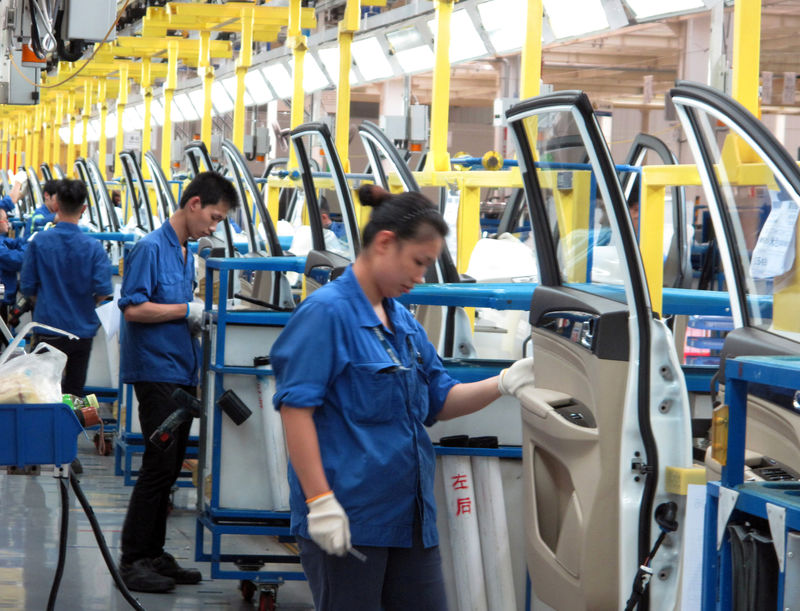By Elias Glenn
BEIJING (Reuters) - Growth in China's manufacturing sector unexpectedly accelerated in August, suggesting the world's second-largest economy is still expanding at a healthy clip despite rising financing costs and a cooling housing market.
Along with stronger U.S. economic growth reported overnight, China's official factory readings indicated the global economy remains on solid footing for now, despite concerns that growth may begin to fade in coming months.
China's resilience so far this year has surprised economists and given an extra boost to a global recovery despite Beijing's crackdown on riskier types of lending and ever-tougher curbs to get the overheated housing market under control.
The official Purchasing Managers' Index (PMI) released on Thursday rose to 51.7 in August from the previous month's 51.4, confounding economists' expectations for a marginal decline.
Production, total new orders and business expectations all shifted into higher gear, while a separate industry survey showed activity in the steel sector expanded at the fastest pace since April 2016 thanks to a year-long, government-led construction boom.
In particular, a sharp pick-up in input prices bodes well for resource companies' earnings and investment in coming months, ANZ said.
"The price-driven recovery will continue at least in the third quarter", said Raymond Yeung, Greater China chief economist for ANZ in Hong Kong.
"On the demand side, infrastructure spending and fixed asset investment continue to maintain (at decent levels)...I see no reason for a sharp downturn even after the fourth quarter this year."
The sustained rally in industrial commodities' prices largely reflects stronger demand for building materials and government efforts to reduce excess capacity by shutting inefficient and heavily polluting mines and mills.
Demand is so robust that futures prices for steel reinforcing bars used in construction have surged 9 percent this month and more than 50 percent this year.
Output prices also rose at the fastest pace since December, indicating strong pricing power for producers, which should fatten profit margins and give firms extra breathing room in the country's fight against a rapid build-up in debt.
"We expect domestic steel production and sales to remain strong in September, with market prices remaining elevated," the China Federation of Logistics & Purchasing (CFLP) said in survey on the sector.
DEFYING GRAVITY?
China's economy grew by a faster-than-expected 6.9 percent in the first half, with resurgent exports and robust retail sales adding to the momentum from the infrastructure building spree and record lending by state-controlled banks last year.
China watchers still maintain the economy will start to lose some altitude eventually, as higher financing costs for companies and homeowners start to drag on activity.
But they do not foresee a sharp slowdown, especially as the government is keen to ensure stability ahead of a once-in-five-years Communist Party leadership reshuffle in the autumn.
After a strong start to 2017, the government looks certain to comfortably meet or beat its full-year growth target of around 6.5 percent. ANZ is forecasting 6.7 percent.
However, analysts did note a number of areas that bear watching, including a slowdown in new export orders.
A separate official reading on China's services sector showed expansion slowed to 53.4 in August from 54.5 in July, the slowest pace of growth since May 2016, but still comfortably above a reading of 50, which separates growth from contraction.
China's leaders are counting on growth in services and consumption to rebalance their economic growth model from its heavy reliance on investment and exports.
Slower growth was seen in the property and financial sectors, while the information technology, broadcasting and aviation industries expanded strongly, the National Bureau of Statistics (NBS) said in a statement along with the data.
A sub-index for the construction sector fell to 58.0 in August from 62.5 in July.
While still quite robust, the lower reading may suggest the strong economic impulse from the massive government infrastructure spending is starting to fade.
Data for July came in mostly below expectations as growth in imports faltered, while industrial output grew at the slowest pace since early this year.
"Looking ahead, if we are right to believe that tighter policy will continue to weigh on investment spending in the coming quarters, then we doubt that the current pace of industrial output growth can be sustained for long," Capital Economics' economist Julian Evans-Pritchard wrote in a note.
The data on Thursday showed manufacturers cranked up production in August, with a reading of 54.1 from 53.5 in July, while new factory orders rose to 53.1 from 52.8 in July.

That suggested domestic demand picked up, as export orders fell to 50.4, the lowest reading since January and down from the previous month's 50.9.